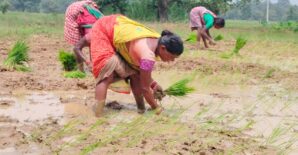Trade agreements bolster trade flows, but policymakers have traditionally restricted trade in agriculture. The Agreement on Agriculture (AoA) of the World Trade Organization (WTO) liberalized agricultural trade, and import tariffs plummeted, but technical know-how is still concentrated among developed nations and agriculture still a topic of negotiation at the WTO. India has prioritized the negotiation of free trade agreements.
Negotiating market access for agriculture products will improve only trade flows, whereas India needs to change the structure of its approach and shape a new generation of trade agreements.
Export surge
The Covid-19 pandemic presented a litmus test of the global demand for Indian agricultural exports. And it seems it passed: exports in 2020 and so far in 2021, exceed that before the pandemic. The new agricultural export policy was implemented in 2018, and agricultural exports are expected to touch $40–45 billion in FY 2021–22.
Agriculture exports, including marine products, have already grown 22 per cent in the current period over the corresponding period last year. In calendar year 2020, India exported agricultural products, including fisheries products, worth $42.07 billion to the world, up from $40.83 billion in the previous calendar year. Cereals, tea, coffee, spices, and sugar confectioneries experienced the most growth. The exports of tea, coffee, rice, other cereals, cashew, spices, fruits and vegetables, and meat and marine products grew in the period between April 2021 and October 2021.
But the proportion of processed agricultural products is insignificant, and exports to countries or blocs India has a regional trade agreement with, is $10.20 billion, only 24.22 per cent of its total exports of $42.07 billion. The rest is exported to the US, and countries in Africa and the Middle East, that do not have a regional trade agreement with India. Most African and Middle East nations are severely or moderately dependent on food imports (UNCTAD Statistics). India is negotiating trade agreements with these nations; it can supply them agriculture products and help ensure food security in return for fresh greenfield investments in food processing and technological know-how.
Logistics glitches
The pandemic delayed shipments, raising the freight cost and affecting exporters’ competitiveness. Agricultural commodities are perishable; and so logistics must be robust, containers made available timely, and freight costs stabilized. The ability to process products and add value at competitive prices, capacity to produce and meet quality standards, and ensuring delivery on time is more important than reducing import tariffs, which has mostly been a focus on the negotiating table. India must engage in dialogue to ensure importing nations of its capabilities and include these issues in the negotiation’s framework.
Digitization and technologies that ensure minimal contact will continue to grow in importance after the pandemic; and collaborating on niche agricultural technologies is crucial. India should include in negotiations the issues of exchanging agricultural technology and related services and exporting value-added agriculture products through technology transfer.
Establishing brands can help farmers gain competitive advantage in ‘buyer-driven’ global markets. California almonds, Chilean wines, and Swiss chocolates enjoy a high stature in their respective product groups and are globally recognized. Branding differentiates products and adds value because consumers perceive that the quality of branded products is superior to that of unbranded products.
Branded items usually fetch better prices and can command customer loyalty. Except for Basmati rice and a few horticultural products like Maha-Grapes, India has not been able to take advantage of its unique positioning for many agri-commodities. The issue of providing Indian agricultural exports an international geographical indication, therefore, should be included in negotiating trade agreements.
Non-tariff measures span the competencies of several ministries, and the coordination mechanisms required to make the trade-offs necessary do not exist. So, India must negotiate to standardize these measures. India must also improve the quality of its fresh and processed products and upgrade standards by sensitizing (and building capacity of) farmers, processors, exporters, and other stakeholders on the issues around sanitary and phytosanitary (SPS) measures. And in the case of a discrepancy or unreasonably high standards set by an importing country or bloc, the exporters and export promotion agencies must raise concerns at both bilateral and multilateral forums.
India has engaged itself continuously at various forums of the WTO with the aim to benefit the country’s agri-trade. The new Farm Laws, which were expected to promote the ecosystem of storage and agri-logistics, enhanced stockholding limits, etc. which were aimed to boost agri-exports, have since been repealed. Therefore, to create a sense of discipline and predictability, current Agricultural Exports Policy must address the challenges and incorporate such unmissable components.
As WTO is based on the principles of non-discrimination, free trade, and promotion of fair competition among the member countries, and the AoA having been conceived as a part of the continuing process of negotiations, India should debate and position its strengths to achieve substantial progress on its huge potential of agricultural exports.
Anjani Kumar is a senior research fellow at International Food Policy Research Institute, New Delhi; Abhishek Jha is a senior econometrician at Dun & Bradstreet Technologies and Data Service, Chennai; and Arabinda K Padhee is Country Director-India at ICRISAT, Hyderabad.
This piece was first published in The Hindu Business Line.



